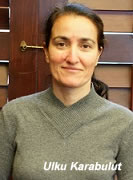Choices, Choices,
Choices the Key to “V”ictory for Inclusion
by Phillip
Conatser & Ulku
Karabulut
People say "a picture" is worth 1,000 words and often helps
to explain ideas. Well, the authors hope this is true because,
in this article several illustrations will be presented depicting
how to set up inclusive activities. Follow these simple suggestions
and equipment ideas and you'll create an environment that
fosters inclusion.
In general, the transition of ideas from the written word
to actual practice is difficult. Applying inclusion ideas
to the gymnasium often seems almost impossible. After years
of teaching inclusion classes at the university, we understand
that students quickly forget what was learned in the classroom
and fall back on old behaviors. In fact, most future physical
educators are ingrained with "sports" activities that have
rules, specific equipment, and one set of standards, which
is the opposite of inclusion.
Because most games and skills taught and played are for the
middle 68% of the population - it's perhaps understandable
to try to make the biggest group happy - little thought is
given to the high-end and the low-end ability levels. The
children with advanced abilities are bored to death with the
rinky-dink un-challenging games, while the lower-end are frustrated
and over-challenged because they are unable to do the skills.
In both cases, children are not being challenged at their
unique level.
Helping university students overcome this deep-seated teaching
style requires a healthy dose of hands-on practice with children
who have disabilities as well as lesson plans that include
drawings of inclusion strategies (as illustrated in this article).
And we've discovered that novice teachers seem to retain and
actually practice inclusion strategies more often when using
a combination of learning methods.
Inclusion does not have to be hard; it can be as easy as
telling the children to choose a ball they want and go play.
Without designating rules and using official equipment, children
have the opportunity to be creative and challenge themselves
at their unique level. In this
Baseball drawing, children can choose the distance they
want to throw the ball and what type of ball they want to
throw.
Like all good students, children in PE have been conditioned
to lineup, but we advise PE teachers to discourage parallel
lines of children playing and the use of parallel lines on
the gym floor. Parallel lines limit expectations, self-challenge,
and choices in play. If you as a teacher notice children forming
lines, tell them they can move closer or further apart as
well as encourage the use of different type of balls and equipment.
The shape of the "V" in victory is a great visual to remind
us of the continuum of choices that allows all ability levels
"high-medium-low" to succeed.
The volleyball
illustration shows the game being played with official
rules, court dimensions, and equipment (high level). It can
also be performed in a lower level form of play by offering
choices in group size, type/amount of balls used, net high,
and no out-of-bound lines. For instance, for children in wheelchairs
or walkers a badminton racket might be a better choice to
hit a balloon. For children with a weak grip, a strap or velcro
could be used to fasten the hand to the racquet. Equipment
that is soft or floats will not hurt or injure players and
is easier to hit over the net. Further, using many beach balls
and balloons will give more opportunities to strike the ball.
Other modifications might be, before the ball is hit over
the net all team members must touch the ball before going
over the net or all the red balls are to be used by Jose (who
uses a wheelchair).
Medium level play also offers choices in net height, team
size, type of ball, and number of balls used. However, medium
level may include official volleyballs, regulation high net,
and children making up their own rules for the game. Whatever
the level of play, PE teachers should monitor activity to
determine if adjustments are needed in equipment (more/less
balls, net high/low, soft/hard ball), team size, and if children
are engaged and having opportunities to practice skills.
Modifications for medium and lower level basketball
play for children who want a noncompetitive game to work
on their fundamental can include:
- Smaller and lighter objects to shoot or dribble (bean
bags, tennis ball, volleyball, Nerf ball, rubber kickball).
- Lowering the basket, placing a
hula-hoop under the basket, placing hula-hoops at different
heights on the wall, trash cans, boxes or coffee cans could
all be used as targets.
- Giving all children many balls
to use when practicing.
- Teams use different number of players.
- More than one ball used in a game.
- If only one ball is used, then
all teammates must touch the ball before shooting a basket.
- Play games based on a set time
not by score.
- 4-goal basketball game that includes
choices of balls, baskets, and teammates.
Notice, how you can create an environment in which high level
players/athletes have the opportunity for competition and
to challenge their skills during a game, as well as children
who want a noncompetitive game or just want to work on their
fundamentals.
The final
illustration shows an example of extended skills stations.
Each station focuses on a skill that has been given some thought
as to how many different ways it can be performed. A major
key to being inclusive is to think of any skill and ask yourself
"how could the skill be done harder or easier, backward or
forward, higher or lower, side-to-side, one or two arm(s)
or leg(s), with equipment that is lighter or heavier, longer
or shorter, thinner or fatter, and at a distance that is close
or far." Also, choices in the playing surface impact how fast
a ball might roll and/or the children's ability to move. For
example, a child who uses a walker or a wheelchair could move
more easy on a hard surface (black top, gym floor) than a
soft surface (grass, gravel). If these questions are asked
and applied you will witness all level of players being successful.
Children can also be given the opportunity to think of different
ways to do a skill. For example, children have added ideas
to the "jump rope" illustration, such as (a) for kids with
limited jumping ability to place the rope on the ground to
jump over; (b) spinning a long rope around like a helicopter
to jump over; and (c) high ability level students could have
a rope hooped around one ankle and challenged to swing the
rope so it can be jumped over by the other foot.
Other examples, could be using a heavy rope and jumping on
one leg to make it harder or challenging a child who uses
a wheelchair to practice circular motions with the 2- piece
jump rope trainer or holding one end of a longer jump rope
as peers jump.
The Underhand Throw station can
be made more or less challenging by changing the distance,
target size, or object thrown. For example, throwing a washer
into a coffee can 10yds away is much harder than landing a
beanbag in a hula-hoop 5 feet away. Having different sized
containers (boxes, boards, cans, targets) and objects (bean
bags, washers, squeeze balls, tennis balls) also increases
children's overall throwing variability. These variations
challenge the throwing skills of children of all abilities
rather than insisting that everyone throws the same ball at
the same target from the same distance.
At the Ladder station skill differences
are used to make the task harder or easier (no equipment changes).
Children can hop with both feet or one foot, jump over one
square or several squares, and/or high knee sideways, backward,
or zigzag through the ladder. Place pictures by the ladder
to encourage students to try different movement skills.
Finally, the Bowling station illustrates
how children can be creative when given the opportunity: Alley
distances are different, size-shape-weight of pins different,
arrangement of pins different, and types of bowling balls
different. Also children used a variety of ways to propel
the bowling ball such as the "granny shot," 1 step - 6 step
approach, backward between the legs, and for children who
use a wheelchair a ramp can be added. Notice than an official
bowling situation (balls, pins, alley, rules, scoring) is
also provided as an alternative choice for students.
When children transition and move from station-to-station
let them choose from a variety of skills (skip, hop, walk
backwards, etc.). Also when transiting from the gym to the
field have children perform a skill. Another transition tip
that will help give children more time in PE is to have the
classroom teacher bring them to the gym. Physical education
"time" should not be spent in the hallways.
If PE teachers follow these simple "choice" suggestions and
equipment ideas children with high-medium-low abilities will
have a better chance of being challenged and also succeeding
at their own unique ability level.
Biography: Phillip Conatser is an Associate Professor, Department
of Health and Human Performance, at the Univiversity of Texas,
Brownsville. Read his biographical information here. http://www.utb.edu/vpaa/coe/Pages/PhillipConatser.aspx
Biography: Ulku Karabulut is an Assistant Professor, Department
of Health and Human Performance, at the Univiversity of Texas,
Brownsville. Read her biographical information here. https://www.utb.edu/vpaa/coe/Pages/UlkuKarabulut.aspx
(back
to pelinks4u homepage) |





